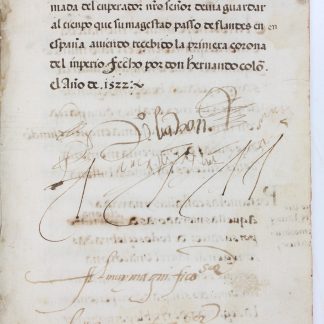"Li quatro ordeni delle Terre di Germania". Anonymous list of the imperial quaternions.
½ fol. leaf (divided vertically). Italian manuscript on paper. 1 p.
€ 650.00
Elegantly disposed manuscript list of the so-called imperial quaternions (from Latin: quaternio, "group of four soldiers"), the conventional representation of the Imperial States of the Holy Roman Empire that was established in the 15th century. The list in groups of four largely follows the usual descending order of precedence, the exception being the Noblemen (here: "Baroni") who moved up the list: Dukes, Margraves, Landgraves, Burggraves, Noblemen, Counts, Knights, Cities, Villages, and Peasants. Added in a different hand are the "four Vicars" and the "four [Castles]", as well as seemingly random numbers to the quaternions listed above. These additions correspond to the representation of the Imperial States on the Quaternion Eagle, the informal coat of arms of the Holy Roman Empire that has been introduced around 1510 by Hans Burgkmair. Here, the coats of the quaternions, with the exception of the highest tiers (emperor, kings, prince-bishops, and prince electors), are grouped vertically on the twelve feathers of the Eagle, adding up to a total of 48 States: 1st Peasants, 2nd Cities, 3rd Noblemen, 4th Burggraves, 5th Margraves, 6th Dukes, 7th Vicars, 8th Landgaves, 9th Counts, 10th Knights, 11th Villages, and 12th Castles.
With minimal tears. Some browning.






